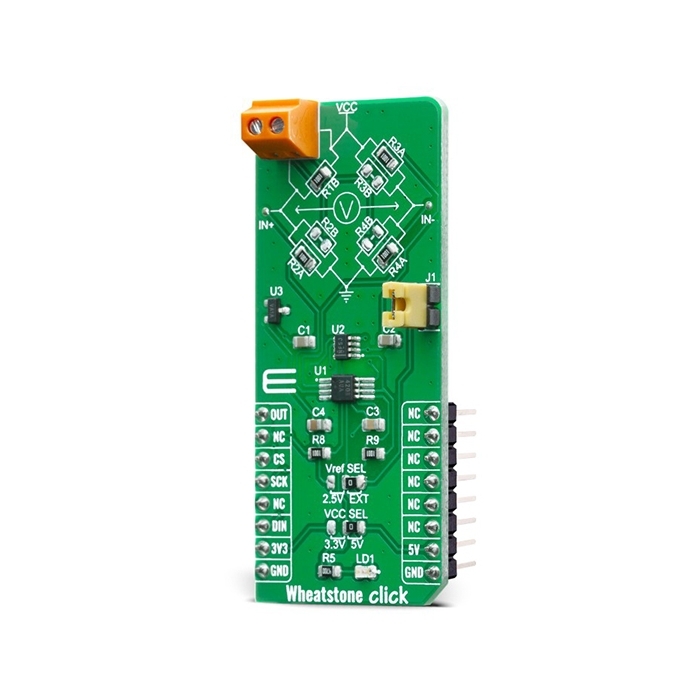MIKROE Wheatstone Click
Wheatstone Click is a measurement Click board™ which utilizes a Wheatstone bridge circuit onboard.
Product Overview
Wheatstone Click is a measurement Click board™ which utilizes a Wheatstone bridge circuit onboard, in order to precisely measure the resistance of an external element. Besides the wheatstone bridge circuit, this Click board™ also utilizes MAX4208 – an ultra-low offset/drift, precision instrumentation amplifier, from Analog Devices. Having features such as Spread-Spectrum, Auto-Zero, Low Offset Voltage Drift and more makes the mentioned IC ideal for accurate detection of very small voltage changes and conversion into a digital form. Having these features in mind, Wheatstone Click is ideal for using in various applications which may include sensor readings and precise resistance measurements.
Wheatstone Click is supported by a mikroSDK compliant library, which includes functions that simplify software development.
A Wheatstone bridge is an electrical circuit used to measure an unknown electrical resistance by balancing two branches of a bridge circuit, one branch of which includes the unknown component. The primary benefit of the circuit is its ability to provide extremely accurate measurements, in contrast with a simple voltage divider.
The R2, R3, and R4 are resistors of known resistance (1k ohm), while the resistance R1 is brought to the terminal block and therefore it is changeable. With no resistance connected to the terminal block, the bridge on this Click board™ is in balance. At this point, the voltage between the two midpoints (IN- and IN+) will be zero. Therefore the ratio of the two resistances in the known branch (R1 and R3) is equal to the ratio of the two resistances in the unknown leg (R2 and R4). If the external resistance is connected to the terminal block, bridge is unbalanced, and the voltage on the midpoints is proportional to the external resistor value.
Wheatstone Click is based around the MAX4208 IC, which is connected to an onboard Wheatstone bridge circuit, in order to precisely measure the resistance of an external element. The mentioned IC uses a spreadspectrum, autozeroing technique that constantly measures and corrects the input offset, eliminating drift over time and temperature and the effect of 1/f noise. This technique achieves less than 20μV offset voltage, allows ground-sensing capability, provides ultra-low CMOS input bias current and increased common-mode rejection performance. It also provides high-impedance inputs, optimized for small-signal differential voltages (±100mV), which makes it ideal for an application such as wheatstone bridge disbalance measurement.
This Click board™ also has TPL0501 onboard - 256-Taps, Single-Channel, Digital Potentiometer With SPI Interface, from texas instruments. It is connected to the MAX4208 in a way that it serves an gain adjust instead of with two external resistors
The power supply voltage selection for the logic section is done by moving the SMD jumper labeled as VCC SEL to a desired position: left position to select 3.3V, right position to select 5V. This will allow both 3.3V and 5V MCUs to be interfaced with the Click board™ directly.
Features & Specs
- Interface: Analog, SPI
- Compatibility: mikroBUS™
- Dimensions: 57.15 x 25.4mm
- Input Voltage: 3.3V or 5V
Documentation
Customer Reviews


